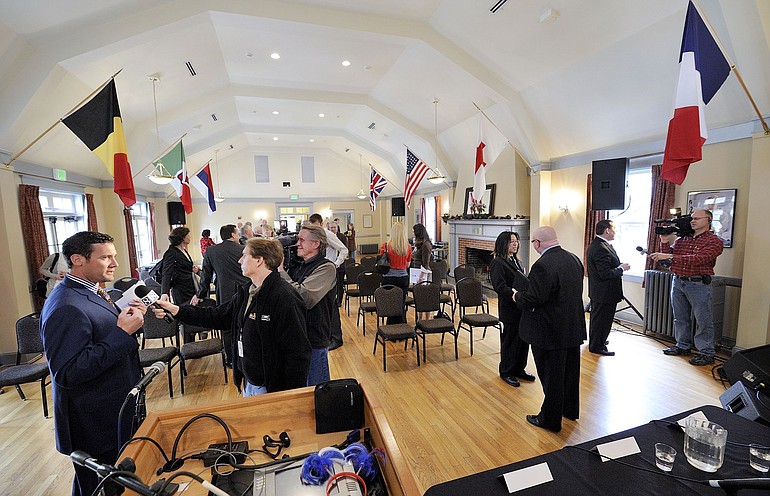They’re just across the street from one another, but the Post Hospital and the Red Cross building in the West Barracks are in two different worlds.
One could be ready for a ghost movie, with broken windows boarded over and official “U.S. Property No Trespassing” signs posted. The other has been lovingly restored, with dozens of culinary and hospitality students streaming in and out daily. Weddings and other celebrations are regular events.
The largely abandoned Post Hospital and the bustling Red Cross building are really two sides of the same coin, say officials with the Fort Vancouver National Trust, which manages and develops the city of Vancouver-owned West Barracks and Officers Row on the Fort Vancouver National Site.
The two historic icons are at two different places on a journey the city and the trust would ultimately like to see all of the homes, barracks and other landmarks on the property complete.
“You can just see the potential for this to be great,” Bob Cromwell, National Park Service archaeologist, said as he walked through the debris and vacant spaces of the area’s massive Artillery Barracks just east of the Red Cross building.
“In many ways I see this as a mini Presidio situation,” he said, referring to the massive restoration of the Army’s former Presidio fort in San Francisco. Since 1994, the Presidio has been a part of the Golden Gate National Recreation Area, a unit of the Park Service.
Examples of what the area could be dot Fort Vancouver’s landscape: Officers Row, 21 stately homes restored with $10.9 million in city funds in the 1980s, is a mix of commercial and residential space. It’s a popular choice — the commercial property is at about a 3 percent vacancy, while the apartments are always rented out, said Michael True, Fort Vancouver National Trust chief financial officer.
The Red Cross building was brought back to life in 2004, with nearly $2 million in state, federal and city money. Today, it (along with the nearby restored soldiers’ mess hall) is home to the International Air & Hospitality Academy.
“It’s probably the best example of adaptive reuse,” Cromwell said. “To put a current use that matches the historical use always works really well.”
Brick homes that once housed officers located to the south of the Artillery Barracks are now duplexes.
In all cases, the work that the city and trust does pays to bring the buildings up to code, and to install basics such as heating and cooling, said Elson Strahan, Fort Vancouver National Trust president and CEO. Developers do the rest of the work.
Now, with many of the smaller buildings on the West Barracks restored and occupied, Strahan sees two big challenges ahead — the Post Hospital and the Artillery Barracks buildings.
Both stand unoccupied, save a small wing of the hospital that the trust’s maintenance staff uses. Both are huge: The 1905 hospital is 30,000 square feet; the Artillery Barracks, built in 1904, is 40,016 square feet.
But Strahan has ideas for both of them.
He envisions the Artillery Barracks as a stately historic inn, complementing the “hospitality complex” of the nearby Air & Hospitality Academy. In 2004, founder and former academy owner and Vancouver resident Arch Miller included plans for a hotel in the nearby Infantry Barracks when he announced a massive investment in the area, that included putting in a branch of his school there and reopening the Grant House restaurant.
Then, Strahan said, the economy went south.
“We were pretty far along in that process and then the economy took a downturn,” he said. “The markets are just not here right now to move forward.”
It will take some money to bring the building up to a developer’s standards. Built to house two artillery companies, the attic section was used as a firing range. The lead from their bullets permeates the top floor.
The city recently installed a new sprinkler system and roof, but disability access, heating and cooling and other structural fixes are still needed.
Also, dividing the massive empty spaces that once held hundreds of bunks into individual rooms may take some wrangling with the Secretary of the Interior’s standards for rehabilitation, Cromwell said.
“We think this is a good space for a hotel, but it may be difficult,” he said.
Talk of turning the Post Hospital into a hotel also floated around for some time, however. officials now say the hospital, which saw tens of thousands of soldiers during World War I and World War II, is too long and narrow and too close to Interstate 5 to make that happen.
Today, the trust hopes to partner with Vancouver nonprofit Southwest Washington Center for the Arts to renovate the space to create an arts and education center, Strahan said. It’s a reverse of the plans for the Post Hospital and the Artillery Barracks: Five years ago, hopes were to start an artist’s collective called the Artillery Barracks there.
Patient and surgery rooms could be perfect for artists’ studios, and the massive windows on both the north and south sides of the building provide excellent light, Strahan said. Gallery rooms would be performance and education space.
Once the several million dollars in repairs and other required fixes are made, “we really can use the space much as it is,” Strahan said. “We’re just targeting getting it up to where it is functionally habitable for those purposes.”
Finding the money, he acknowledged, “is our challenge.”
Plans to get the arts center under way have been in the works for a few years now, but the timing of the Columbia River Crossing project has put the hospital on hold.
“We moved it to back burner, because we needed to assess the impact,” Strahan said. “Plans are still gelling. It’s a little bit premature to launch a capital campaign.”



